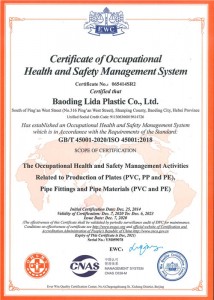ಆಕ್ಟೋ . 10, 2024 17:57 Back to list
ppr cold water pipe
Understanding the Importance of PPR Cold Water Pipes
In the realm of plumbing and water distribution, the material used for pipes plays a crucial role in determining the efficiency, longevity, and safety of water delivery systems. Among various materials, Polypropylene Random Copolymer (PPR) is gaining significant popularity, especially for cold water applications. This article delves into the advantages of using PPR cold water pipes and their contribution to modern plumbing solutions.
What is PPR?
Polypropylene Random Copolymer, commonly referred to as PPR, is a type of plastic that is frequently used in piping systems. Its unique molecular structure allows for flexibility, durability, and resistance to high temperatures, becoming an ideal choice for various applications, including cold water distribution.
Advantages of PPR Cold Water Pipes
1. Corrosion Resistance One of the most significant advantages of PPR pipes is their resistance to corrosion. Unlike metal pipes, which can rust and corrode over time, PPR pipes remain resistant to chemical reactions with water and other substances, ensuring a longer lifespan and reducing the need for frequent replacements.
2. Low Thermal Conductivity PPR pipes have low thermal conductivity, which means they are less likely to conduct heat. This property is particularly important for cold water systems, as it helps maintain the desired temperature of the water without excessive heat loss, making PPR an energy-efficient choice.
3. Lightweight and Easy to Handle PPR pipes are lightweight compared to traditional metal pipes, making them easier to transport, handle, and install. This can significantly reduce labor costs and installation times, making PPR a cost-effective choice for both residential and commercial plumbing projects.
ppr cold water pipe

4. High Pressure Resistance PPR pipes are designed to withstand high pressure, making them suitable for various cold water applications, including those in high-rise buildings or industrial settings. Their robustness ensures that the integrity of the plumbing system is maintained even under challenging conditions.
5. Eco-Friendly Material PPR is a recyclable material, which makes it an environmentally friendly option compared to other plastic materials. The use of PPR helps support sustainability efforts, as it reduces the environmental impact associated with the production and disposal of plumbing materials.
Installation and Maintenance
Installing PPR cold water pipes is straightforward, thanks to the ease of connection and the availability of various fittings. The most common method used is the heat fusion technique, where the ends of the pipes are heated and then joined together, creating a strong and leak-proof bond.
Maintenance of PPR pipes is minimal, as they are resistant to scaling and deposition. This ensures a clean and efficient flow of water, reducing the likelihood of blockages or reduced water quality over time.
Conclusion
In conclusion, PPR cold water pipes represent a modern solution for plumbing systems across various sectors. Their numerous advantages, including corrosion resistance, lightweight nature, high pressure resistance, and eco-friendly characteristics, make them an ideal choice for cold water applications. As the demand for efficient and sustainable plumbing solutions continues to grow, PPR pipes stand out as a reliable option for both new constructions and renovations. By choosing PPR, customers can ensure a more sustainable and long-lasting plumbing system, benefiting both their immediate needs and the environment.
-
PVC Transparent Sheet Roll - Durable & Flexible PVC Plastic Sheet Roll for Industrial & Home Use
NewsJun.24,2025
-
High-Quality PVC PPR Pipes and Fittings Durable ERA PPR Solutions
NewsJun.10,2025
-
High-Quality Large HDPE Sheets & Large Diameter PVC Pipe Durable Large PVC Pipe Supplier
NewsJun.10,2025
-
High Density Polyethylene Cutting Board - Durable & Food Safe
NewsJun.09,2025
-
3 Inch PVC Pipe for Durable Irrigation Affordable & Reliable
NewsJun.09,2025
-
Premium PPR Plastic Water Pipe Fittings - Durable & Leak-Free
NewsJun.09,2025

